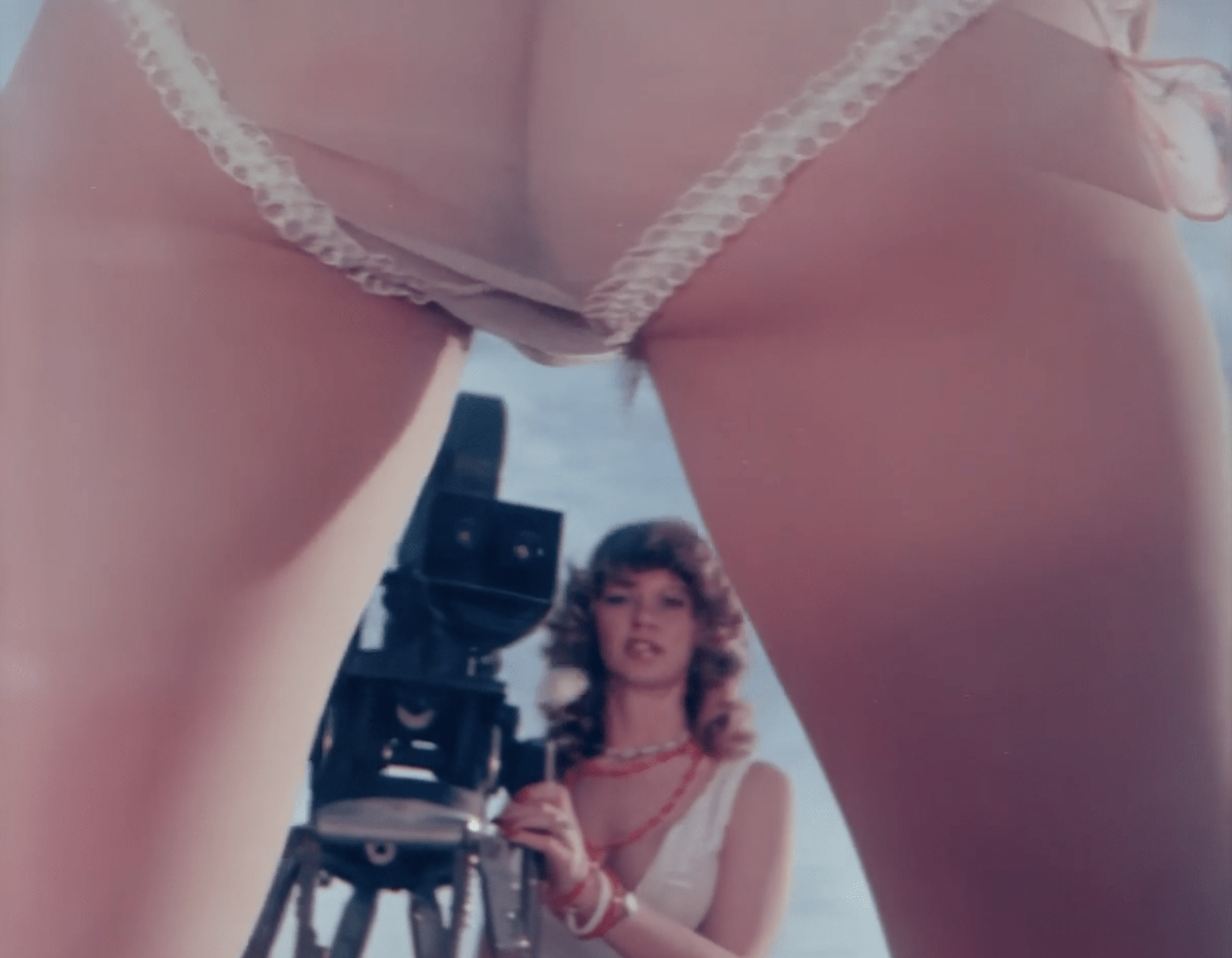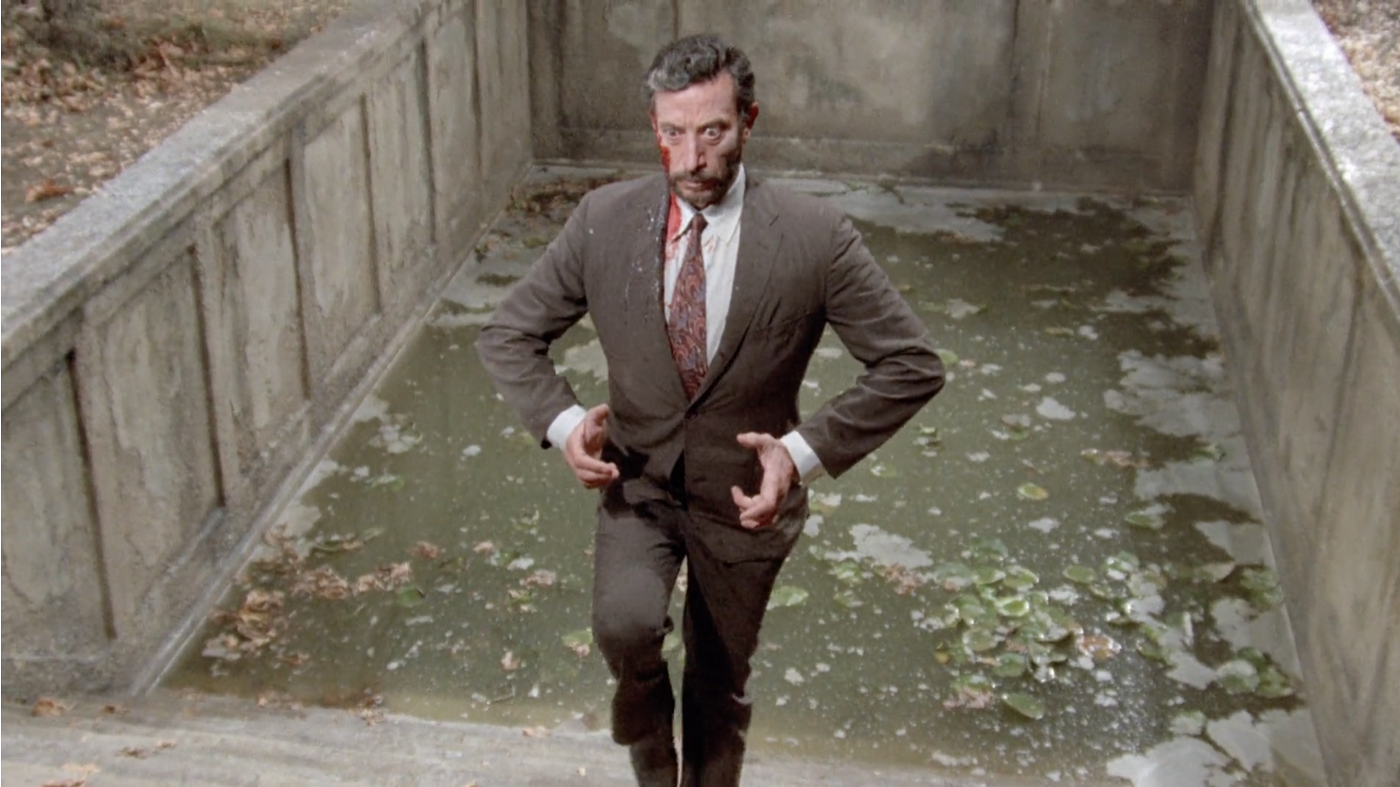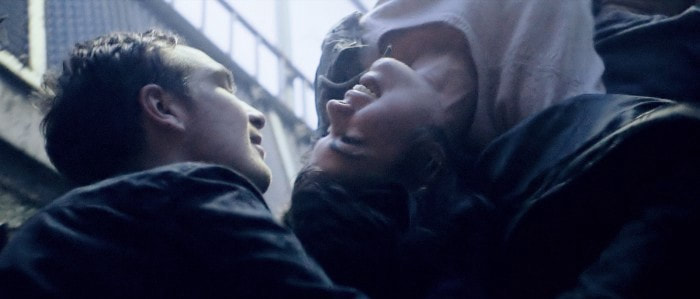
Béla Tarr’s film Sátántangó is formidable. Not simply because it is 7.5 hours long, but because any exposure to Bela Tarr’s world view is a rough ride. He was 39 when he made Sátántangó in 1994, but the film, like all of his films, is world weary and dark as dark can be. Béla Tarr has his own version of existentialism that is closer to the old school of Schopenhauer and Nietzsche than The French existentialist school of Camus and Sartre. For the
French the lack of meaning in our existence, was a liberation. It was an opportunity to discover life’s value anew, but Tarr dumps a heavy bucket of dripping mud on Sartre’s cafe table, burying Sartre’s jaunty pipe and glass of wine in an irreversible “Fuck you” to the discovery of anything. Sartre looks up at Tarr and asks “Pourquoi?” And Tarr just silently trudges off. The camera watches Tarr recede step by plodding step into the background in a single continuous, ten minute shot until he is a dark dot on the horizon. Fade to black.
Sátántangó is an incredible achievement, a masterful and monumental vision, but I did not watch it the way Tarr intended. I watched it over several days in multiple sitting on a tv screen in my living room. David Lynch would smack me across the face for my impudence but I can’t imagine sitting in a theater for 7.5 hours, even with two intermissions. I am sure that the full experience the way Tarr intended would have been different but I’m not sure it would have been a positive one. Maybe it wasn’t meant to be.
While Sartre was hashing out existentialism in a cafe in Paris, a different existentialist, Ingmar Bergman, was wrestling with his own version on the rocky cliffs of Sweden. In The Seventh Seal, Antonius Blok confesses on his knees to the personification of death, “We must make an idol out of our fear and call it god.” I remember when I first heard that line. It felt so harsh in its direct simplicity. For Bergman we are weak, and trapped. We are engaged in a self-defining struggle that might not be ennobling but is at least admirable. 40 years later Tarr had his own version of angst voiced by his character Irimiás in Sátántangó, “They sit in the kitchen, shit in the corner, and look out the window every now and then to see what the others do.” For Tarr it’s all a waste of time. We ourselves are a waste of time.

Sátántangó was shot in low contrast. On a grey scale where 1 is the brightest white and 10 is the darkest black the film takes place entirely between 3 and 8.There is nothing dark and nothing bright. The contrast and the pacing reinforce each other. Its like a pall that settles on you creating a weighty atmosphere. The mood and feel of the film are very strong, very present.
The film unfurls like a möbius strip that seems to be moving forward until you realize you are back where you started. Every 40 minutes or so you find yourself at a point earlier in the film even though it seemed that you were moving straight ahead. Its not so much disorienting as it is part of the pacing of the film. You expect Tarr’s films to be slow, and this one surely is, but the möbius strip adds an element of timelessness. Almost as if it is mythological. In addition its cyclical motion removes a sense of progress and purpose. There is a sense that the movie isn’t getting anywhere.

The title, Sátántangó, foreshadows this lack of progress with its invocation of the Tango which requires the dancers to take six steps forward and six steps back. There is quite a bit of dancing in the film, including the tango. Tarr has a particular talent for depicting what should be a pleasurable experience, as something joyless.
In his film The Turin Horse there are several scenes where his characters eat potatoes. They burn their fingers while they try to scoop up the boiled, un-spiced flesh. They hurriedly push the pieces into their mouths. They suck in air to cool it and then swallow as if they were taking a pill. I have never seen a meal so devoid of pleasure.
In Sátántangó Tarr’s characters stumble drunkenly around the bar grabbing, pulling, pushing and jostling each other in a drunken stupor that mimes dancing but is bereft of anything enjoyable. They seem to be harassing each other more than anything else. The scene is very long and dreary. Its reminiscent of Otto Dix’s paintings of Weimar Germany, where the people pose as if to flirt or exude glamor but they only succeed in looking debauched and grotesque.

There are many aspects of Sátántangó that strongly resemble Samuel Becket’s Waiting for Godot. There is a similar dark sense of humor at the expense of everyone. There is the same sense of cyclical time and cyclical thoughts, but it is the waiting for resolution that really feels similar. In Waiting for Godot our two protagonists are waiting for a mysterious person. He is named Godot but he remains undescribed and unexplained. He can be seen as God, or meaning, or a leader, but whoever he is, he is meant to imbue their lives with value, and recognize and validate the fact that they waited for him.
In Sátántangó the characters wait for Irimiás, a real person who eventually does actually arrive, 4.5 hours into the film. Like the characters in Waiting For Godot, the villagers of Sátántangó look to their new arrival for more than just a resolution to their problems, they hope Irimiás will bring purpose to their lives and a future to orient their hopes.

Irimiás arrives and immediately provides exactly what the villagers are looking for. Speaking to them as a group he encourages them, “Go ahead and think of your future. From now on my friends you are free.” Throughout the film Irimiás’ motivations are suspect. Why has he returned? Is he a ghost? Is he a spy for the government? Is he a con man or a thief? In the end it doesn’t really matter, what matters is that the villagers trust him and look to him as a savior. The film is not about Irimiás, It’s about the villagers. Its about their inability to take charge of their own lives. They are unable to act in their own self-interest never mind each others. They think only as far as the next glass of palinka.
Instead of seeing this as a reproach against the Hungarian masses, which it may well be, it can be seen as more of a general statement about us all. We humans have a tendency to ignore our own internal power and instead externalize it as an authority that oppresses us. It is as simple as our making God and then believing that he made us. Taking a cue from Bergman, we create an idol of our fear and then fear it as if came from an external source.
One of the darkest moments in the film is when a young girl named Estike tortures her cat. It is an intense scene where we see a girl who feels powerless exert power over the only thing she can. Unfortunately this carefully crafted and dramatic scene looks very much as if it involved some genuine animal abuse. Tarr said it was supervised by a veterinarian, but that does not diminish the awful treatment the cat receives at the hands of a young girl. I was actually as concerned for the young actress as much as I was for the cat. Neither are physically harmed but both are made to participate in what looks to me like genuine torture. There is no doubt that the scene was meaningful and in line with the film’s purpose but what the young actress was made to do to the cat is not acceptable.

Estike and her cat constitute one of the most intense and bleak moments in Sátántangó, and yet they provide one of the only moments of transcendence in the film. After poisoning the cat, she poisons herself and as the child awaits her own death she imagines that her passing connects her to all living things. She at least is at peace with a death we see as meaningless and unnecessary, but she sees as a resolution.
Unless one is ready to write 40,0000 words the full exploration of this film is not an option. There are so many possible interpretations, so many symbols to be explored, so many possible themes and ideas that one can only record a set of impressions. In reference to Sátántangó Tarr once said, “We have a story but I think the story is only a little part of the whole movie.” The richness of the film overwhelms any straight forward narrative. The story’s structure is just a scaffold to hold up a complex interplay of observations and ideas.
Near the end of the film the screen goes black and we hear a voice say “Leave out the thing about eternity.” As the next scene appears we see that the line was spoken by a bureaucrat dictating to a typist. Sátántangó was based on a novel by the same name written by László Krasznahorkai. Tarr and Krasznahorkai worked together on the film and the scene between the bureaucrat and the typist reenacts their collaboration. Within the plot of film the scene has a specific purpose but it feels much more like an opportunity to step away from the reality of the film and peek behind the curtain at the authors. Not only the authors but the ones who are in control, the orchestrators. There are many god-like figures in Sátántangó, the bureaucrat, Irimiás, and young Estike who functions as a Christlike sacrifice that the villagers are lead to believe will lead to their redemption. Tarr refers to these spiritual ideas but keeps everyone’s feet firmly planted in pig shit and mud.

Tarr is often likened to Tarkovsky. There is no doubt that their gliding camera’s and slow pacing create similar effects but there is an important difference. Tarkovsky’s films are contemplative. The camera seems curious about what it sees. Despite the seriousness of his films, Tarkovsky is revelatory. Tarr’s slow camera also encourages us to be observant, but whatever optimism that exists in Tarkovsky implied or explicit, Tarr does not display. The length of his shots are heavy and challenging, like a morbid curiosity.
Tarkovsky is spiritual and deeply poetic. In his film Nostalgia we watch a man try to carry a lit candle across an empty swimming pool. Its one uninterrupted 9 minute shot that captures everything you could want to know about being human. It is painful and beautiful, anxious and ennobling, hopeless and hopeful. You can feel Tarkovsky’s love and frustration for humanity.
This is not the way Tarr operates. Formally they are similar but in Tarr’s hands the scene would have taken 30 minutes and there is no doubt the candle would have gone out. It is too reductive to say that Tarr is simply more pessimistic. His relationship to the film and to his audience is different from Tarkovsky’s.
Like his characters, Tarr’s feet never leave the ground. If he did film the scene with the man and a candle and he did chose to make it 30 minutes it would be because it put emphasis on what is happening over what it might imply or symbolize. 30 minutes would not provide more time for meditative wonderings, it would emphasize the concrete nature of what we are watching. It would require our endurance instead of our contemplation.

Béla Tarr is associated with the slow film movement. Most of what I have read about this movement makes it sound foolish. If the members of this movement were truly slowing their films down in order to combat the increasing speed of contemporary film I would have little interest in it. It sounds reactionary and simplistic. Perhaps it is the summaries of the slow movement that are simplistic, but either way I do not see Béla Tarr, as one engaged in such a fight.
From what is evident in the films he makes, the pacing has far richer and more varied motivations. The pace is directly related to the level of sensitivity the director is asking for. If a camera pans through someone’s bedroom and comes to rest on a figurine on the night table, and then stays there for 40 seconds, the figurine grows in significance. The longer something is in on screen the more important it is.
With Sátántangó the pace is so slow the significance not only has a chance to grow but to wane as well. After awhile we disengage. We are reminded that we are watching a film. Its just an optical illusion of movement that we imbue with meaning. The pacing continually breaks the fourth wall.
You have to wrestle with Sátántangó. It is difficult to imagine someone enjoying every moment of it. There is no doubt that the film is masterful. It overflows with beautifully crafted scenes but the human mind can not stay receptive for 7.5 hours. Our attention wanders and returns. Our emotional equilibrium varies. Our bodies go through physical changes. We need to go to the bathroom, we need to eat, we need to move our muscles. We are a moving target and the film is relentless. The film is long enough that we start to forget the beginning. We can’t hold all of it in our mind at once. As we move forward we forget where we came from.

There are so many long shots of people slowly walking away until they disappear on the horizon, and so many shots where people emerge from the horizon and slowly make there way into view, that the horizon begins to take on a presence or meaning of its own. Its as if something else, something different exists just beyond it. I imagined a staging area where all of the characters exist waiting for their cue. Not the actors, but some narrative limbo where the characters wait their turn. Six steps forward, six steps back.
There are so many memorable scenes in this film but they should be experienced, not described here in writing. Sátántangó asks a lot of its audience but it has a lot to offer. After spending so much time with it, I miss it. Watching it you are drawn into a different way of seeing, and interacting with film. The mind is attracted to novel stimulation. It often wants to repeat anything that spawned a new neural pathway. A new source of dopamine. Sátántangó provides a deep, rich well of emotional and philosophical struggle. I thought I would only want to draw from it once, but I can see that I will have to go back again.

If you enjoyed this article click here for more
www.filmofileshideout.com/archives/a-comparison-of-the-turin-horse-and-the-naked-island



